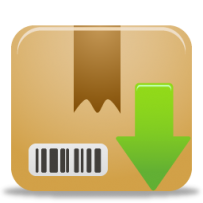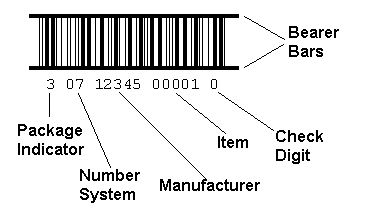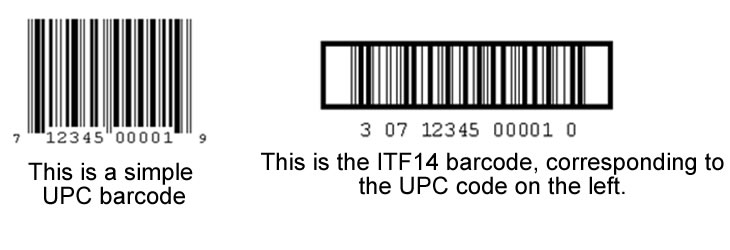ITF14 Barcode – Shipping Container Symbol

ITF14 is a barcode topology also known as Shipping Container Symbol. It is mainly used to designate packages or boxes where many identical products with EAN/UPC barcodes are gathered. ITF stands for Interleaved Two of Five and 14 shows the number of the encoded numeric figures. Actually a simple ITF14 symbol has the structure of an EAN/UPC one but with one extra digit at the beginning.
This extra digit specifies what is the type of the package:
- 0 – UPC code of contents differs from case code
- 1 – More than each and below inner packs
- 2 – Alternative for 1
- 3 – Inner packs
- 4 – Alternative for 3
- 5 – Shipping containers (cartons)
- 6 – Alternative for 5
- 7 – Pallet
- 8 – Reserved by Uniform Code Council for future use
- 9 – Variable quantity content
As I explained in my previous articles, the main function of the barcodes is to represent machinery readable data. Designating every product with a black and white linear label allows everything to be done faster and more accurate.
Manual manipulation might be replaced by computerized scanning but this still isn’t a complete solution as long as most of the companies don’t work with single entities, they use huge quantities of goods, collected in boxes, pallets or even containers. When a shipment of boxes arrives, the receiver has to know the exact number of products in each one. So in the context of modernization and automatization GS1 lead in special packaging barcode – ITF14 (Take into account that the numbers, mentioned below, are absolutely imaginary).
Let’s say that we have a company for soft drinks called “Gazy”. “Gazy” uses Shipping Container Symbol (ITF14) for designating its parcels before sending them to the customers. Our company has agreed to keep up to certain principles. For example our package from level 3 contains 6 items, a carton from level 5 contains 20 packages from level 3 and a pallet from level 7 contains 4 cartons. As a result after scanning the ITF14 codes, our clients will know exactly how many stocks they have received. Of course there might be cases in which you will have to break these standards in order to hold your prospective business partners. Instead of 120 they might want there to be 100 units in a single carton (Level 5). Then the “9” index is used and a small additional zebra-stripped symbol is attached to the main one. It is made of six numerical digits – the last one for data security check and the others showing how many units there are in the package.
The distinctive characteristics of the ITF14 standard don’t end up with the added packaging index. Apart from the data security digit at the end of the barcode there is one more visual feature that guarantees precise and errorless deciphering – the bearer lines. They are black solid horizontal bars situated at the top and at the bottom of a single ITF14. Sometimes, in the fast-going work processes, scanners might read barcodes diagonally. In this way the computer collects only part of the encoded symbols but still presumes that everything is ok. As a result there is wrong data and many consequent problems. With the bearer lines the chances for such mistakes to happen are minor – a scan is regarded as successful only if the whole width of the borders is present. They are just a precaution that ensures the full handling of the encrypted information. Diagonal or any other kind of incorrect scanning is prevented. Download now our ITF14 barcode generator and use it.
ITF14 is not just one of the numerous barcode standards – it is the next step in the process of making the world around us better and not so sophisticated. ITF14 is irreplaceable part of the big barcode family. Thanks to it human manual work is now done by computers and readers and our live is much more alleviated. Here you can find all Mobilio’s barcode generators and download them from the Mac AppStore.



